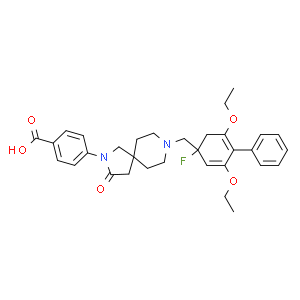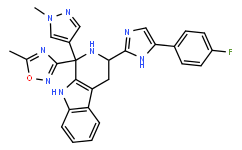| 中文名称: | CH 275 | ||||
|---|---|---|---|---|---|
| 英文名称: | CH 275 | ||||
| 别名: | 34-amino-31-(4-aminobutyl)-13,25,28-tribenzyl-10,16-bis(1-hydroxyethyl)-7-(hydroxymethyl)-22-(1H-indol-3-ylmethyl)-9,12,15,18,21,24,27,30,33-nonaoxo-19-[[4-[(propan-2-ylamino)methyl]phenyl]methyl]-1,2-dithia-5,8,11,14,17,20,23,26,29,32-decazacyclopentatriacontane-4-carboxylic acid | ||||
| CAS No: | 174688-78-9 | 分子式: | C74H96N14O15S2 | 分子量: | 1485.77 |
| CAS No: | 174688-78-9 | ||||
| 分子式: | C74H96N14O15S2 | ||||
| 分子量: | 1485.77 | ||||
基本信息
|
产品编号: |
C11543 |
||||
|
产品名称: |
CH 275 |
||||
|
CAS: |
174688-78-9 |
储存条件 |
粉末 |
-20℃ |
四年 |
|
分子式: |
溶于液体 |
-80℃ |
二年 |
||
|
分子量: |
1485.77 |
|
|
||
|
化学名: |
34-amino-31-(4-aminobutyl)-13,25,28-tribenzyl-10,16-bis(1-hydroxyethyl)-7-(hydroxymethyl)-22-(1H-indol-3-ylmethyl)-9,12,15,18,21,24,27,30,33-nonaoxo-19-[[4-[(propan-2-ylamino)methyl]phenyl]methyl]-1,2-dithia-5,8,11,14,17,20,23,26,29,32-decazacyclopentatriacontane-4-carboxylic acid |
||||
|
Solubility (25°C): |
|||||
|
体外:
|
DMSO |
|
|||
|
Ethanol |
|
||||
|
Water |
|
||||
|
体内(现配现用): |
|
||||
|
<1mg/ml表示微溶或不溶。 |
|||||
|
普西唐提供的所有化合物浓度为内部测试所得,实际溶液度可能与公布值有所偏差,属于正常的批间细微差异现象。 |
|||||
|
请根据产品在不同溶剂中的溶解度选择合适的溶剂配制储备液;⼀旦配成溶液,请分装保存,避免反复冻融造成的产品失效。 |
|||||
生物活性
|
产品描述 |
一种生长抑素的肽类似物。 |
|
靶点 |
IC50:30.9nM; Ki:52nM (somatostatin receptor 1) IC50:345nM (somatostatin receptor 3) |
|
体外研究 |
CH275 (100 nM) activates neprilysin activity, wheras treatment with cyclo-SRIF can complete this activation in vitro in primary neuron-based cell culture system, a mixture of wildtype hippocampal,cortical and striatal neuron. |
|
体内研究 |
CH275 (osmotic pump administration;56μM;two weeks) decreases the level of neprilysin/SRIF in the App knock-in mice.CH275 directly injects into the Lacunosum molecular layer (Lmol) layer of 2-month-old AppNL-G-F mice for four months.App NL-G-F mice begin to exhibit Aβ plaques at two months of age,but CH275 leads to robustly increased the expression of neprilysin in hippocampus which is paralleled by a clear reduction in Aβ plaque load in the same region, and without causing any toxic side effects. |
本计算器可帮助您计算出特定溶液中溶质的质量、溶液浓度和体积之间的关系,公式为:
质量 (g) = 浓度 (mol/L) x 体积 (L) x 分子量 (g/mol)
摩尔浓度计算公式
用本工具协助配置特定浓度的溶液,使用的计算公式为:
开始浓度 x 开始体积 = 最终浓度 x 最终体积
稀释公式
稀释公式一般简略地表示为:C1V1 = C2V2 ( 输入 输出 )









